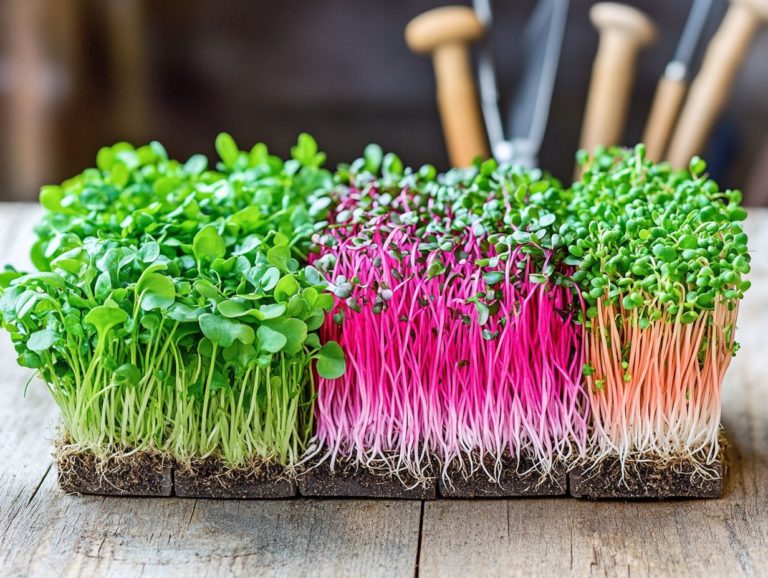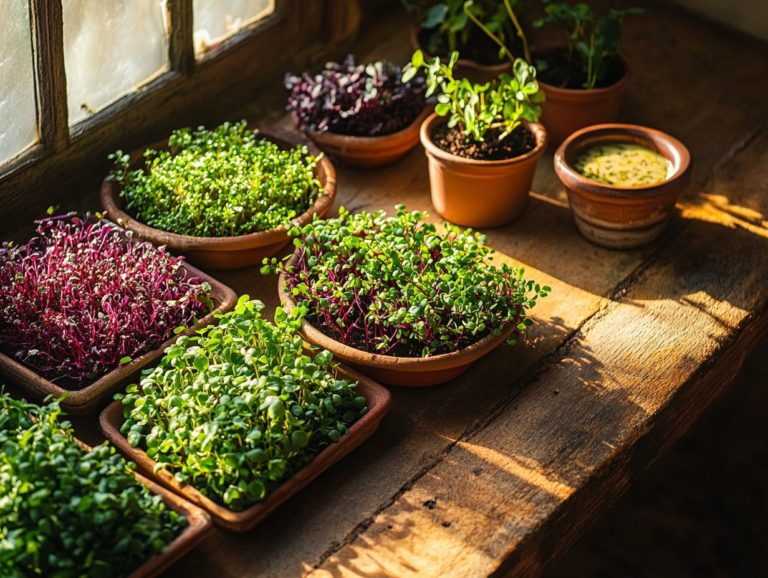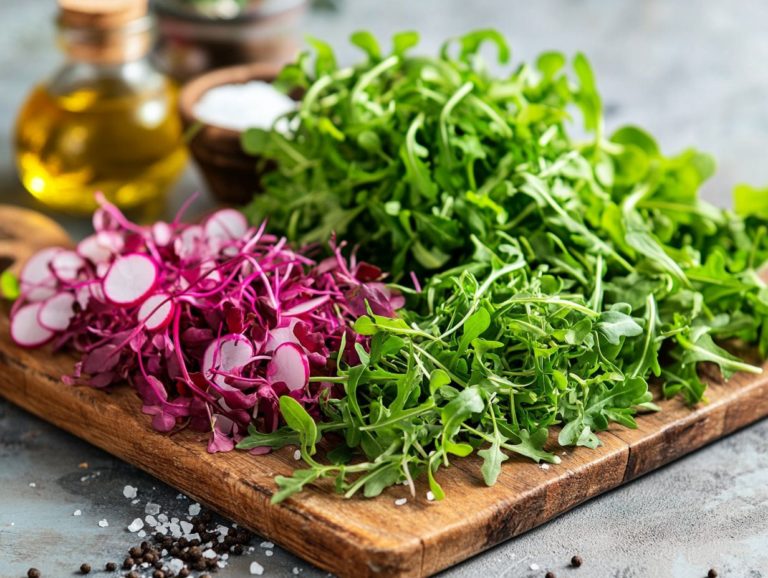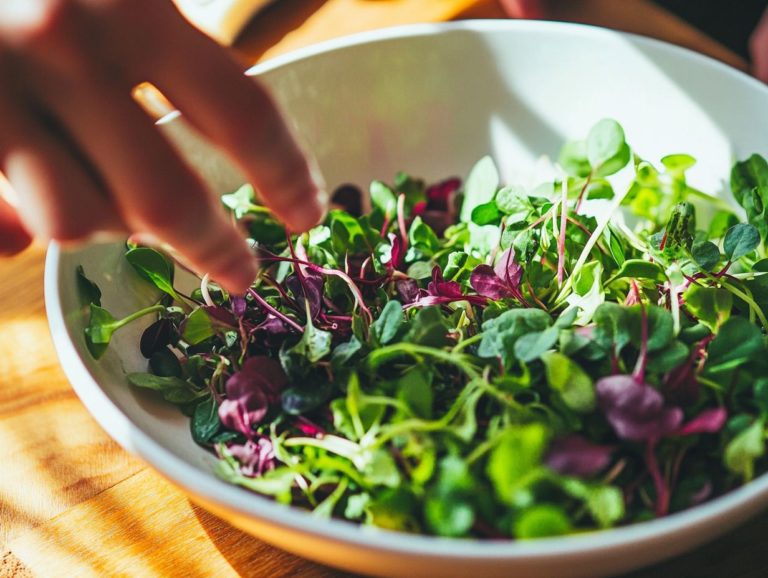Understanding Microgreens and Their Health Advantages
Microgreens are tiny, nutrient-packed plants. They have captured the attention of chefs worldwide.
These greens add vibrant colors and delightful flavors to your dishes. They also offer impressive health benefits.
Explore the world of microgreens and discover their nutritional advantages over fully grown vegetables. Uncover the key nutrients that can enhance your well-being.
Learn creative ways to include them in your meals. Gather tips for growing your own, and discover best practices for purchasing and storing these gems.
Discover the incredible health benefits of microgreens today! You ll be amazed at how they can boost your wellness.
Contents
- Key Takeaways:
- What are Microgreens?
- Nutritional Value of Microgreens
- Health Benefits of Microgreens
- How to Incorporate Microgreens into Your Diet
- Growing Your Own Microgreens
- Buying and Storing Microgreens
- Tips for Choosing and Preserving Fresh Microgreens
- Frequently Asked Questions
- What are microgreens and why are they considered healthy?
- What types of microgreens are available and how do they differ?
- What are the health advantages of including microgreens in your diet?
- How can microgreens be incorporated into meals?
- Are there any potential risks or precautions to consider when consuming microgreens?
- Are microgreens suitable for everyone, including children and elderly individuals?
Key Takeaways:

- Microgreens are young, nutrient-dense greens that are harvested just after sprouting.
- They contain higher concentrations of certain nutrients, such as vitamins C and E, linked to improved immune function.
- Incorporate microgreens into salads, sandwiches, and smoothies for a fresh boost!
What are Microgreens?
Microgreens are a captivating array of young vegetables, including culinary treasures like arugula, spinach, and red cabbage. These tiny greens deliver an impressive nutritional boost.
Harvested just after their first true leaves emerge, they not only catch the eye but also offer bold flavor profiles that can elevate any dish. Their versatility enhances everything from salads and sandwiches to smoothies, infusing them with a fresh, vibrant taste.
Their small size makes them perfect for eating raw. This is why both chefs and home cooks have made them a go-to favorite.
Definition and Characteristics
Microgreens are the edible young seedlings of vegetables and herbs, often from the Brassicaceae family. They stand out with their vibrant colors and bold flavors.
These delightful greens typically make their debut just after the sprouting stage, showcasing unique attributes like tender leaves and stems. They are usually harvested when they are one to three inches tall, making them a perfect addition to various dishes due to their concentrated nutrient profiles. To learn more about their benefits, check out what nutrients microgreens provide.
Unlike sprouts, which are just soaked seeds, microgreens bring a whole host of vitamins and minerals to the table, including vitamins C, E, and K, along with essential antioxidants.
Incorporating microgreens into your diet can yield significant health benefits. They elevate your culinary presentations and enhance your well-being through their rich nutrient content.
Nutritional Value of Microgreens
Microgreens are truly remarkable for their exceptional nutritional value. They often boast higher levels of vitamins, minerals, and plant nutrients compared to their fully grown counterparts.
This makes them a potent addition to any healthy diet, enriching your overall well-being.
Comparing to Full-Grown Vegetables
When you compare microgreens to full-grown vegetables, research indicates microgreens can pack up to 40 times more concentrated nutrients. This includes essential vitamins and minerals vital for your overall health.
This impressive nutrient density means that even a small serving of microgreens can significantly elevate your daily intake of antioxidants. For a deeper look into their benefits, check out understanding the antioxidant capacity of microgreens. These are key players in fighting oxidative stress and inflammation.
For example, a study published in the Journal of Agricultural and Food Chemistry revealed that certain microgreens are abundant in vitamin C and beta-carotene, far surpassing their mature counterparts in health benefits. Plus, the unique flavors and vibrant colors of microgreens make them a delightful addition to various dishes, encouraging a more diverse and nutrient-rich diet overall. It’s no wonder why microgreens are superfoods you need in your meals.
Health Benefits of Microgreens
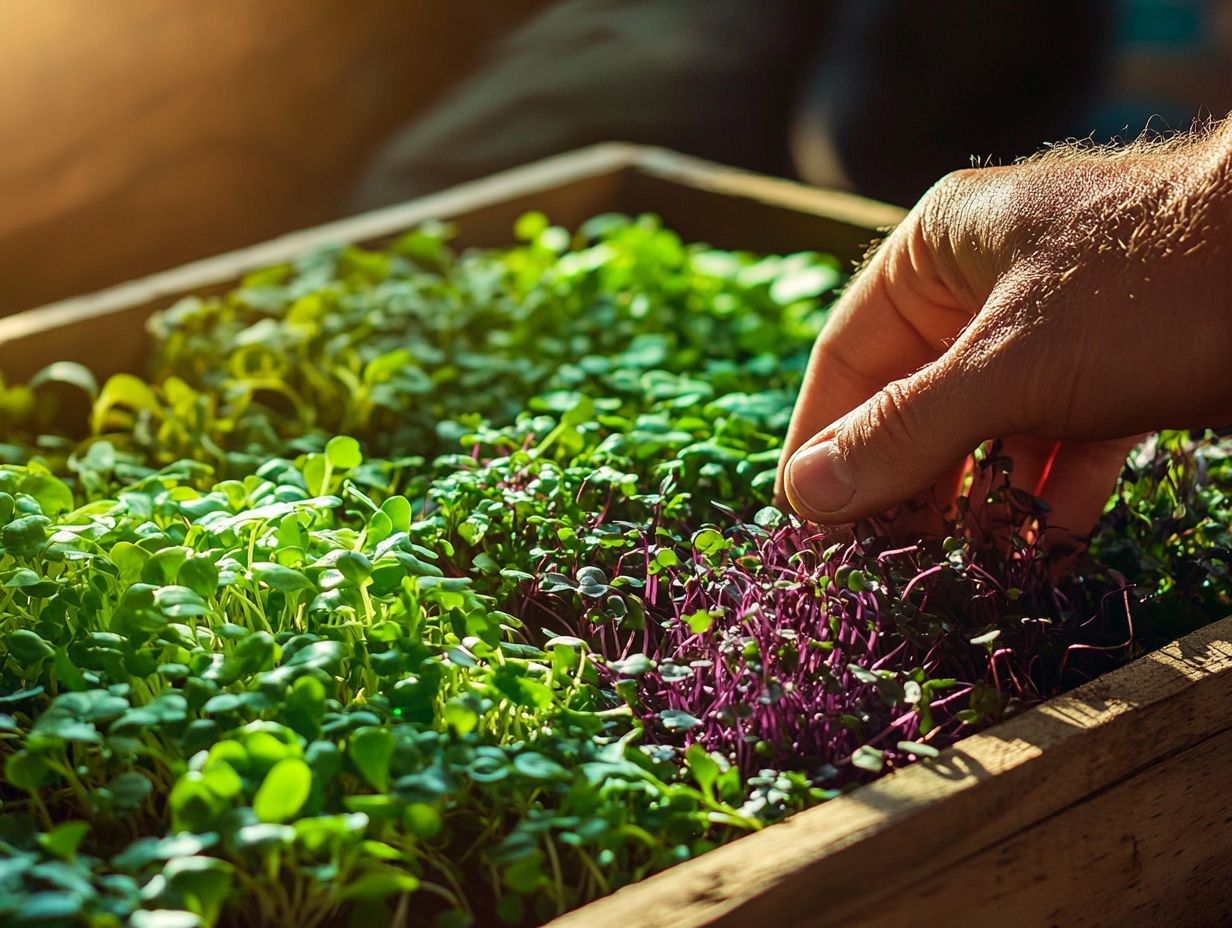
The health benefits of microgreens are truly impressive. They play a significant role in diabetes management thanks to their low glycemic index, which helps maintain stable blood sugar levels.
They are rich in antioxidants and phytonutrients. These compounds may help fight oxidative stress and could reduce cancer risk.
Key Nutrients and Their Effects on Health
Microgreens are a treasure trove of essential nutrients, brimming with vitamins C, E, K, and a myriad of phytonutrients and antioxidants, including sulforaphane, that significantly enhance your overall health and well-being.
Among these petite powerhouses, varieties like spinach microgreens stand out for their impressive iron content, vital for oxygen transport in your blood and can help stave off anemia.
On the other hand, broccoli microgreens are packed with calcium, an essential element for keeping your bones and teeth strong, helping to fend off osteoporosis.
Don’t overlook radish microgreens; they support liver function and detoxification. With such remarkable nutrient profiles, incorporating microgreens into your daily meals can bolster your immune system, reduce inflammation, and lower the risk of chronic diseases. Explore more about unlocking the antioxidant power of microgreens to enhance your health.
How to Incorporate Microgreens into Your Diet
Adding microgreens to your meals is simple and exciting! They can transform your dishes, whether salads, sandwiches, smoothies, or garnishes, infusing flavor and nutrition into every delicious bite.
Creative Ways to Use Microgreens in Meals
From vibrant salads to exquisite garnishes, microgreens can infuse a burst of color and flavor into any meal, establishing themselves as a must-have for health-conscious food enthusiasts.
These tiny greens not only enhance the visual appeal of your dishes but also deliver a powerful nutritional punch, brimming with vitamins and antioxidants. To learn more about how these greens benefit your health, you can explore understanding the nutritional profile of microgreens. As a culinary creative, you can explore an array of varieties, such as radish and pea shoots, to introduce unique textures and flavors to your plates.
Consider layering them in wraps with proteins like grilled chicken or tofu, or even blending them into smoothies for an extra nutrient boost. By thoughtfully pairing microgreens with ingredients like creamy avocado or zesty citrus, you can create balanced meals that are both delightful and nourishing. To learn more about their benefits, check out understanding the health benefits of microgreens.
Growing Your Own Microgreens
Growing your own microgreens is thrilling and rewarding! You’ll have fresh greens at your fingertips that are not only nutritious but also bursting with flavor.
Your Simple Guide to Growing Microgreens

To successfully cultivate microgreens, begin by selecting your seeds, preparing the growing medium, and ensuring your plants receive adequate light, water, and airflow. Keep a close eye on their growth to achieve optimal nutrient density.
Choosing the right seeds is paramount, as different varieties will offer a range of flavors and nutritional benefits. If you’re curious about the specific advantages of these plants, you can learn more about what microgreens are and their benefits. Once you’ve made your selections, prepare an appropriate growing medium options like soil, coconut coir, or hydroponic mats (these mats support plant roots without soil) ensuring that it allows for good drainage and aeration.
Proper lighting is essential; aim for 12 to 16 hours of bright light each day, and don t hesitate to use grow lights if needed to help your seedlings thrive. Regularly check the moisture levels; the growing medium should remain consistently damp but not soggy.
Ensuring ample airflow not only promotes healthy growth but also reduces the risk of mold. Harvesting at the right time will enhance both flavor and nutrient content, elevating your microgreens to their full potential and making them essential for a balanced diet.
Buying and Storing Microgreens
When purchasing microgreens, you should prioritize fresh varieties that boast vibrant colors and are free from any signs of wilting or discoloration. This attention to detail ensures you enjoy the maximum flavor and nutritional benefits these tiny powerhouses have to offer.
Start incorporating microgreens into your meals today for a delicious and nutritious boost!
Tips for Choosing and Preserving Fresh Microgreens
To keep your microgreens fresh, store them in a cool, dry place and opt for breathable containers. This prevents moisture buildup that could spell disaster for their shelf life.
Proper airflow is crucial! Refrigeration keeps microgreens fresh and flavorful. A slightly damp paper towel can be your best friend here. It controls moisture levels during storage and keeps your microgreens crisp without drowning them. To learn more about their benefits, check out what are the benefits of eating microgreens daily.
The nutritional perks of fresh microgreens are remarkable. Packed with high levels of vitamins and minerals, they support overall health. By adding these tiny powerhouses to your meals, you can boost your dishes while enjoying the fantastic benefits of plant-based nutrition. Freshness matters for every bite!
Frequently Asked Questions
What are microgreens and why are they considered healthy?
Microgreens are young, tender greens harvested after the first true leaves have developed. They are known for their high nutrient content, making them a popular choice for health-conscious individuals.
What types of microgreens are available and how do they differ?
There are many types of microgreens available:
- Broccoli
- Kale
- Radish
- Sunflower
Each type differs in taste, texture, and nutrient content, providing a variety of options for your meals.
What are the health advantages of including microgreens in your diet?
Microgreens are packed with essential vitamins and minerals, including vitamin C, vitamin K, folate, and potassium. They also contain high levels of antioxidants, which are compounds that protect your body from damage, helping to support overall health.
How can microgreens be incorporated into meals?
Add microgreens to salads, sandwiches, smoothies, and even use them as garnishes for dishes! They provide a flavorful and nutrient-dense addition to any meal.
Are there any potential risks or precautions to consider when consuming microgreens?
While generally safe, it’s important to wash and handle microgreens properly to prevent contamination. Individuals with certain allergies should be cautious when trying new types of microgreens.
Are microgreens suitable for everyone, including children and elderly individuals?
Yes, microgreens are suitable for people of all ages, as long as they are part of a well-balanced diet. However, it is always recommended to consult with a healthcare professional before making significant dietary changes.
Ready to try microgreens? Add them to your next meal for a delightful and nutritious boost!

